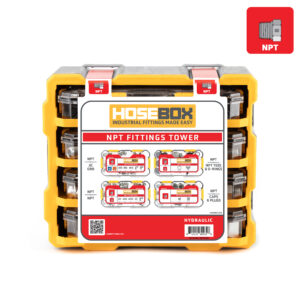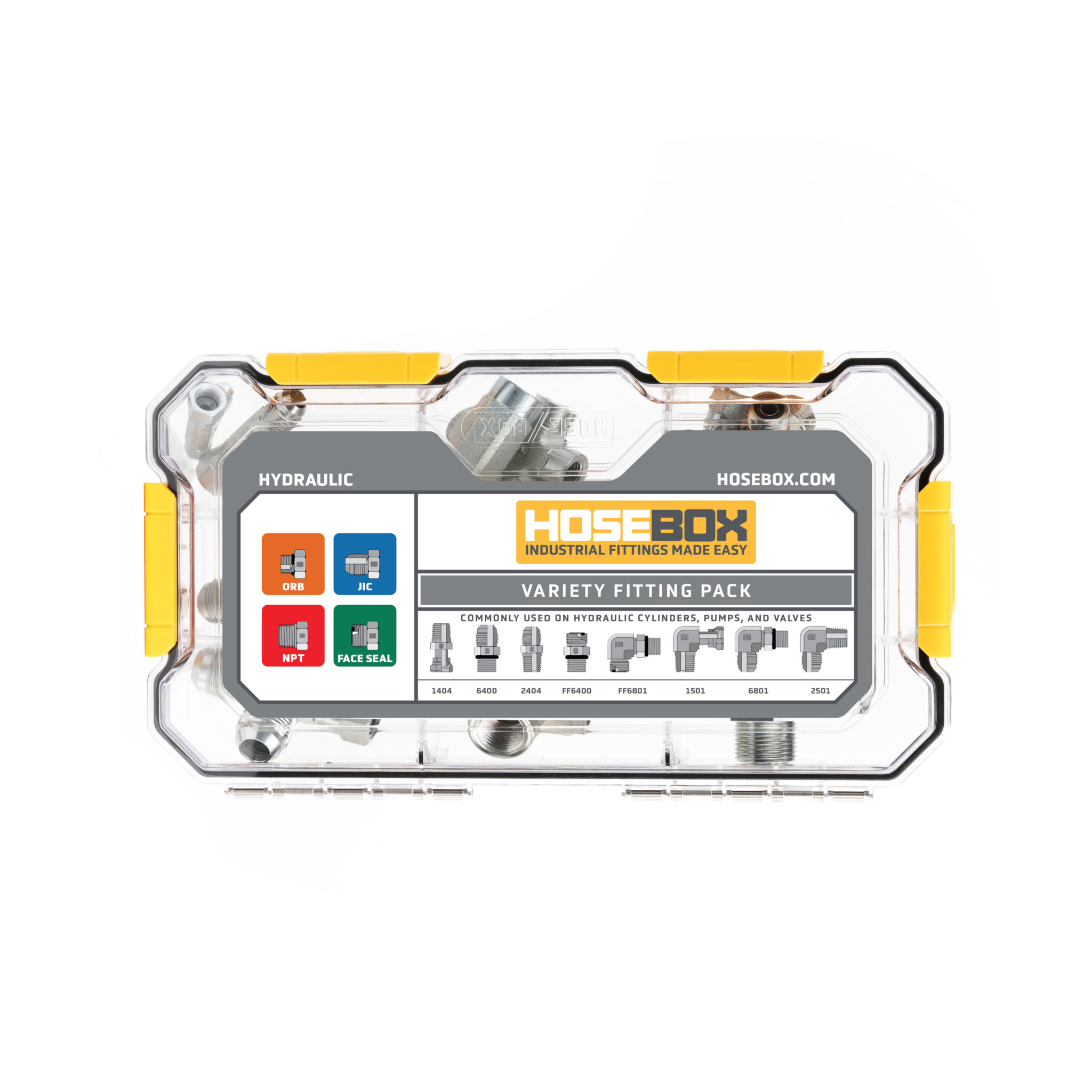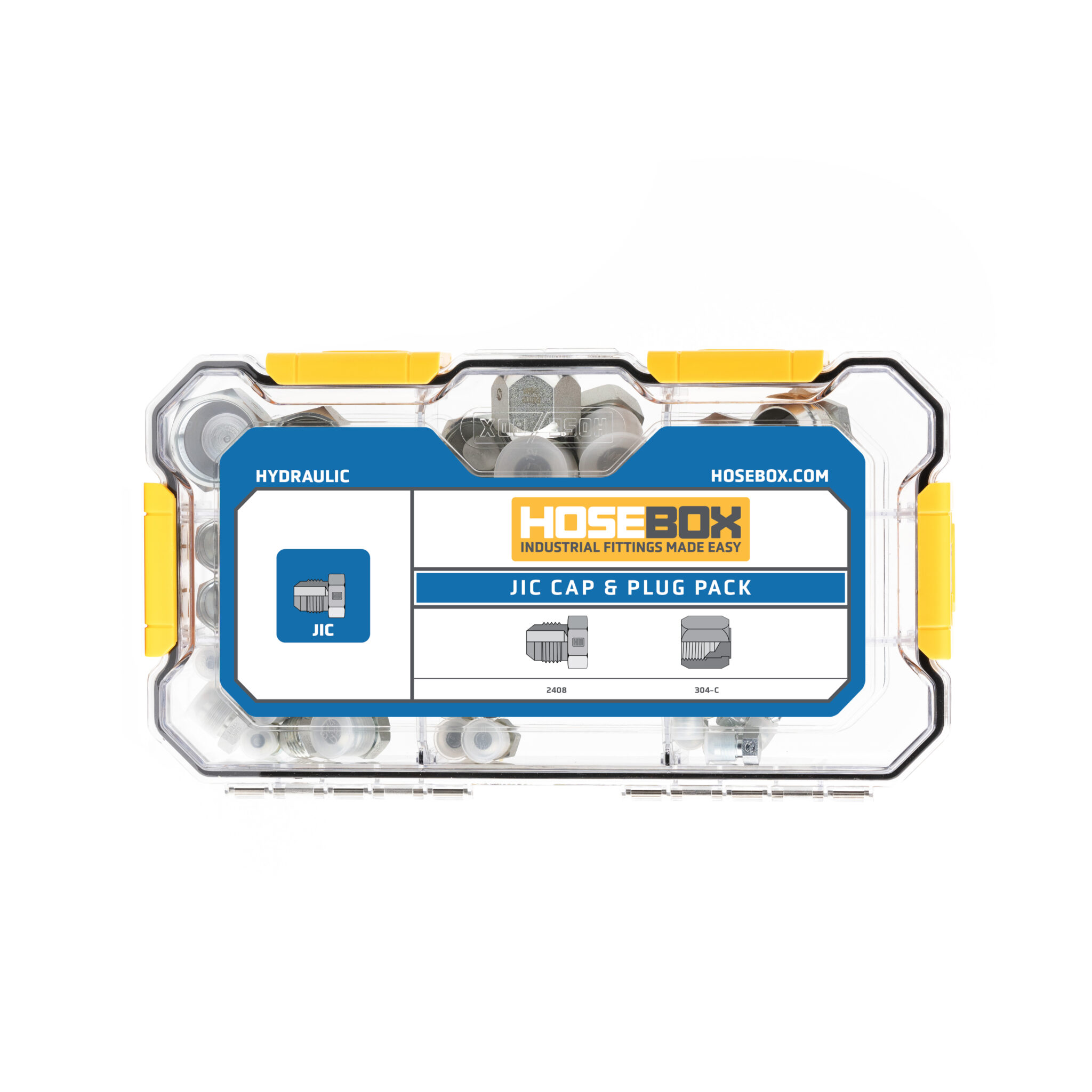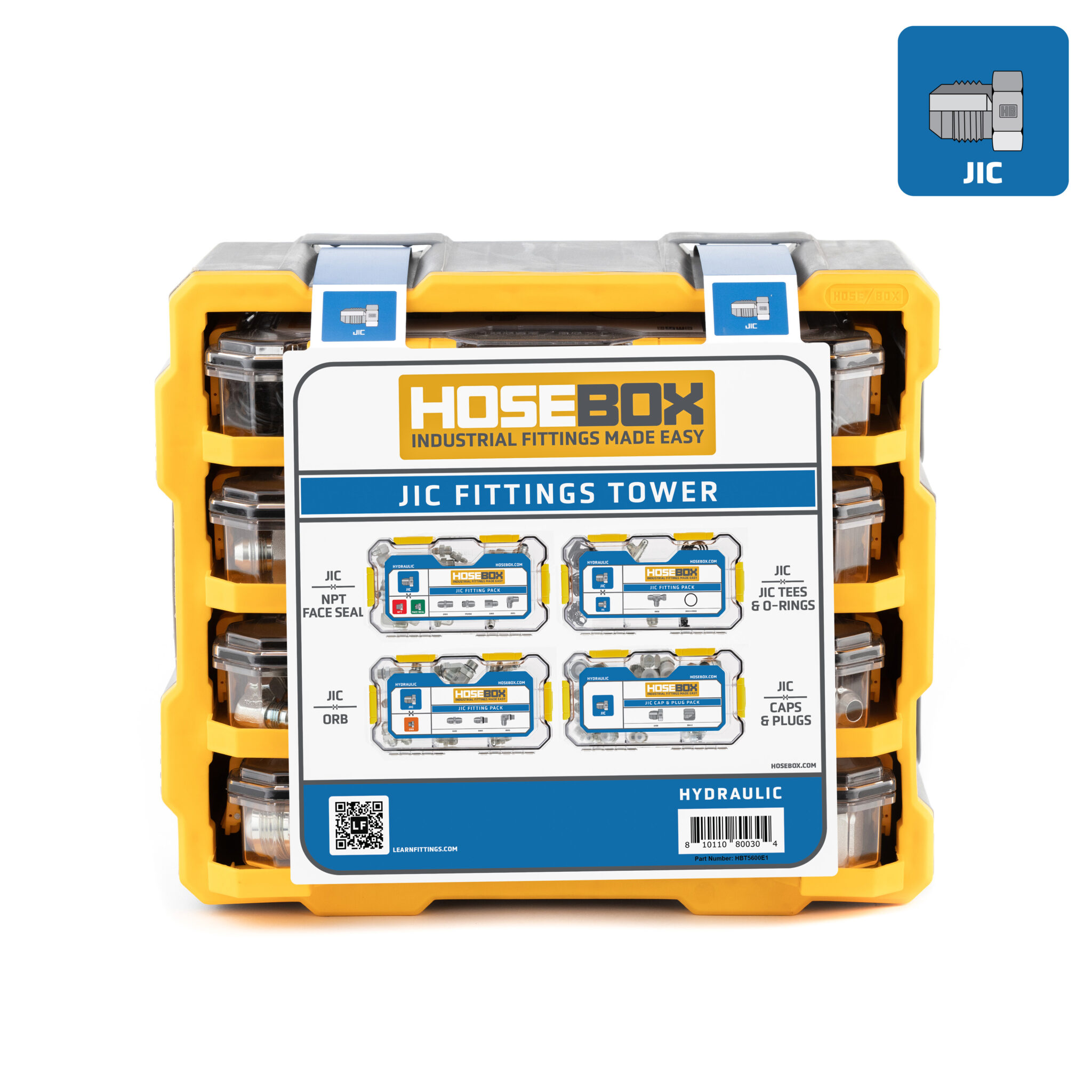If you’re working with hydraulic systems, you’re dealing with NPT fittings. These small but mighty parts play a critical role in ensuring that everything runs smoothly. From the engines of farm equipment to the power steering in heavy-duty vehicles, NPT fittings are hard at work.
In this comprehensive guide, we’ll go over everything you need to know about NPT fittings. We’ll cover the basics, explore different types, and dive into their practical applications. We’ll also introduce you to HoseBox’s selection of NPT fittings, designed to enhance the reliability and efficiency of your hydraulic systems.
So, whether you’re a seasoned pro or just starting in the field, this guide has something for you. Let’s jump right in.
What are NPT Fittings?
When it comes to hydraulic systems, the fittings you use play a crucial role in the efficiency and security of your setup. Among these, NPT fittings stand out for their versatile usage and dependable performance. But what exactly are these components, and how do they function? Let’s dive in.
The Basics of NPT Fittings
At the heart of it, NPT (National Pipe Tapered) fittings are all about connections. Named after the American standards that defined them, they’re designed to connect sections of pipe or hose, facilitating the flow of fluids or gases under pressure.
NPT fittings are easy to recognize, thanks to their distinctive tapered threads. The tapering allows for a deeper, more secure connection as the male and female fittings are twisted together. The farther the threads are engaged, the tighter the seal, resulting in a robust, leak-free connection.
In summary, these fittings are your go-to connectors when it comes to creating secure, pressure-tight seals in your hydraulic systems. They are reliable, versatile, and built to withstand demanding conditions. And while they may appear simple on the surface, there’s more to these fittings than meets the eye. This is where the science behind NPT fittings comes into play.
The Science Behind NPT Fittings
Having covered the basics of NPT fittings, let’s delve deeper into the technical intricacies that set these components apart. Here, we will examine the unique aspects of their design and functionality, such as the tapered thread design, the vital role of thread sealants, and the importance of material choice. These elements are instrumental in delivering the reliable and efficient performance we’ve come to expect from NPT fittings. Brace yourselves as we embark on this fascinating journey into the world of NPT fittings.
The Tapered Thread Design
At the heart of the efficiency of NPT fittings is their unique tapered thread design. This design provides a more secure fit, promoting a tighter and more robust seal compared to other fitting types. Unlike parallel threads, which maintain the same diameter along their length, NPT threads taper off, narrowing towards the end of the fitting. This configuration allows the male and female parts to screw together more tightly, increasing contact and friction between the threads, hence creating a better seal.
While NPT fittings initially offer an effective seal due to their design, it’s not perfect on its own. Over time, high pressure, temperature fluctuations, or mechanical stress could potentially cause leaks. To bolster this inherent sealing ability and create a more leak-proof system, an additional measure comes into play, which we will discuss next: the application of thread sealants.
Let’s dive into that.
The Importance of Thread Sealants
An often overlooked but crucial aspect of NPT fittings is the use of thread sealants. In their native form, while NPT threads can make an excellent mechanical joint, they don’t inherently form a 100% leak-proof seal. That’s where thread sealants come into play.
Thread sealants, such as PTFE tape or pipe joint compounds, serve a dual role. Not only do they fill in the minute spaces between the threads that might otherwise become paths for leakage, but they also lubricate the threads. This lubrication ensures the fittings can be tightly assembled without galling (or seizing up).
Remember, over-application of a sealant can lead to system contamination, which is a leading cause of system failure. Hence, while applying the sealant, one needs to be cautious and ensure it’s applied appropriately, emphasizing the first thread of the fitting.

Material Choice
The choice of material for NPT fittings largely depends on the application’s requirements. It influences the fitting’s durability, corrosion resistance, and its suitability for the fluid it will carry. Here’s a quick look at the common materials used in the construction of NPT fittings:
Brass: This is a widely used material for NPT fittings due to its machinability, strength, and resistance to corrosion and heat. Brass fittings are compatible with a wide range of substances, from water to gasoline, making them versatile for various industries.
Stainless Steel: Known for its superior strength and resistance to corrosion and high temperatures, stainless steel is the go-to choice for harsh or extreme environments. Industries such as chemical processing, oil and gas, and food and beverage commonly use stainless steel NPT fittings.
Steel: Regular steel fittings offer good durability and are cost-effective. However, they lack the corrosion resistance of stainless steel or brass, limiting their applications to environments where corrosion is not a significant concern.
Plastic: Plastic NPT fittings, commonly made from PVC or PTFE, are lightweight, resist corrosion, and are excellent for certain specialized uses. However, they lack the mechanical strength of metal fittings and are not suitable for high-pressure or high-temperature applications.
Every material brings its unique set of properties to the table. Therefore, the choice of material should be carefully made, considering the application’s demands and the fluid the fitting will carry.
Types of NPT Fittings
Navigating the world of NPT fittings can initially seem complex due to the variety of types available. These fittings come in various shapes and sizes, each designed to cater to a specific need or application. By understanding the types of NPT fittings, you can choose the most suitable one for your hydraulic system, ensuring optimal performance and longevity. Let’s delve into the primary types of these fittings:
Male and Female NPT Fittings
The differentiation of NPT fittings into male and female types forms the basic categorization. This segregation is essentially about the fitting’s design and how it connects to other components in a hydraulic system.
Male NPT fittings have threads on the outside and connect to the inside threads of another fitting, typically a female NPT fitting. Their primary purpose is to make leak-proof connections with the female counterparts, often found in pipes, hoses, or other male fittings. They are widely used due to their simplicity and effectiveness.
Female NPT fittings, on the other hand, have threads on the inside. They receive the male NPT fittings and provide a secure, tight connection. These fittings can be found in a plethora of applications, from plumbing to industrial machinery, due to their versatility and robust nature.
NPTF Fittings – An Alternative
For scenarios requiring a more substantial, leak-free seal, NPTF (National Pipe Thread Fuel) fittings are commonly used. They are similar to NPT fittings in design but provide an enhanced level of sealing.
The NPTF fitting’s threads, when tightened, compress against each other, creating a mechanical seal. This seal reduces the need for extra sealants, making NPTF fittings a reliable choice for high-pressure applications. However, they are more prone to damage due to over-tightening, hence requiring careful handling during installation.
By understanding these NPT fitting types, you can make an informed decision about the best fitting for your specific hydraulic needs.
Uses and Applications of NPT Fittings
With a wide variety of uses, NPT are a staple in industries that rely on piping systems. These fittings are crucial components in controlling the flow of liquids or gases through a network of pipes. Let’s examine some of the most common applications and industries that rely heavily on these adaptable connectors.
Industries that Rely on NPT Fittings
Numerous industries depend on this fittings for their operations, including:
Oil and Gas Industry: NPT fittings are commonly found in oil and gas equipment, serving in both upstream and downstream operations. From drilling rigs to refineries, these fittings ensure safe and efficient transport of materials under pressure.
Manufacturing Industry: Within production lines, this fittings play a crucial role in hydraulic systems, pneumatic devices, and cooling systems. Their ability to withstand varying pressure and temperature conditions makes them an excellent choice in these settings.
Automotive Industry: NPT fittings are also prevalent in automotive applications, particularly in fuel and brake systems. They ensure the secure transport of fluids throughout the vehicle, contributing to safety and performance.
Plumbing and HVAC: In residential and commercial settings, NPT ones are a vital part of plumbing and HVAC systems. They provide secure and tight connections, ensuring the smooth and efficient operation of these systems.
Construction Industry: The construction industry depends on heavy-duty equipment like bulldozers, backhoes, and cranes, which heavily utilize hydraulic systems. These hydraulic systems make extensive use of this fittings due to their strength, durability, and ability to withstand high pressures.
Marine Industry: Marine vessels, from small boats to large ships, have intricate plumbing systems for potable water, waste, and fuel. NPT fittings are used extensively in these applications due to their ability to form a reliable seal.
Agriculture Industry: In agricultural applications like irrigation systems, NPT fittings help to connect pipes and hoses efficiently, ensuring the seamless delivery of water across vast farmlands.
Food and Beverage Industry: Breweries, distilleries, and food processing plants use NPT fittings in their production lines. These fittings connect various components in the system, handling various temperatures, pressures, and aggressive cleaning processes.
Practical Applications and Examples
Beyond the industries, let’s delve into a few practical applications of NPT fittings:
Pressure Systems: In systems that deal with high pressure, such as power plants and hydraulic machinery, NPT fittings provide a reliable means of controlling and directing fluid flow.
Cooling Systems: In cooling systems, including those in computers or industrial machinery, NPT fittings help regulate coolant flow, ensuring the equipment stays within safe operating temperatures.
Gas Supply Lines: For natural gas or propane supply lines, NPT fittings create tight and leak-proof connections, ensuring safe and efficient operation.
Hydraulic Systems: In heavy machinery such as tractors and excavators, NPT fittings are essential components in the hydraulic systems. They ensure secure connections between hydraulic lines, contributing to the efficient operation of the equipment.
Pressure Washers: NPT fittings are often used in pressure washer systems, connecting the high-pressure hose to the pump, and the pump to the trigger gun. Their ability to form tight seals under high pressure makes them a great choice for such applications.
Home Plumbing: In residential settings, NPT fittings can be found in various plumbing applications. From connecting pipe sections to installing fixtures like faucets and showerheads, these fittings ensure a secure and leak-proof seal.
Industrial Air Compressors: In industrial settings, fittings are used to connect various components in an air compressor system, from the compressor itself to the air tools being used. They ensure a tight and secure connection, which is vital for the efficient operation of the system.
Breweries and Distilleries: In the beer brewing and distilling process, NPT fittings are used to connect different sections of the system, such as the brew kettle, fermenter, and chiller. Their ability to withstand different temperatures and pressures makes them ideal for this application.
Automotive Fuel Systems: In the automotive industry, NPT fittings are used in the fuel system to connect fuel lines to the engine and fuel tank. Their leak-proof design ensures safe and efficient operation of the vehicle.
Agricultural Irrigation: In the agriculture sector, NPT fittings are used in irrigation systems to connect different sections of pipes and hoses. They provide a tight seal, ensuring the efficient delivery of water to the crops.

These are just a few examples of how NPT fittings are used in various practical applications. Their reliability and versatility make them a popular choice in numerous industries.
How to Install NPT Fittings
Installing NPT fittings correctly is crucial to ensuring a secure and leak-free connection. The process might seem straightforward, but even experienced professionals can occasionally overlook crucial steps. This section will provide a step-by-step guide to installation, as well as common mistakes to avoid.
Step-by-step Guide to Installation
Preparation: Clean all threads to remove any debris. Ensure that the male and female threads match in type and size.
Apply Thread Sealant: Apply a suitable thread sealant, such as PTFE tape or pipe joint compound, to the male threads. Make sure not to over-apply and avoid getting the sealant inside the fitting, which can contaminate the hydraulic system.
Start Hand Tight: Begin by screwing the male fitting into the female fitting by hand. This will ensure the threads are aligned correctly and prevent cross-threading.
Tighten with a Wrench: Once you can no longer tighten by hand, use a wrench to further tighten the fitting. Take note of the turn count – typically, 2-3 turns after hand-tight should suffice.
Check for Leaks: After the hydraulic system is pressurized, check the connection for leaks. If a leak is detected, slightly further tighten the connection, but avoid over-tightening, which can cause damage.
Common Mistakes and How to Avoid Them
Cross-threading: This happens when the male and female threads are not aligned correctly, causing damage to the threads. Always start by hand to ensure proper alignment.
Over-tightening: Over-tightening can distort the threads and result in leaks. Stick to the recommended number of turns after hand-tight.
Wrong Size/Type: Using mismatched fittings can lead to leaks or burst connections. Always check the size and type of your fittings before installation.
Improper use of Sealant: Using too much sealant can contaminate the hydraulic system, while too little might not provide an adequate seal. Always use the right amount and keep it on the threads.
With these guidelines, you can ensure a correct and secure connection every time you install this fittings.
Our NPT Fittings
At HoseBox, we understand the essential role of NPT fittings in your hydraulic systems. That’s why we offer a diverse range of NPT fittings to meet the various demands of different industries.
Exploring HoseBox’s NPT Fittings
HoseBox’s fittings are made from top-quality materials that can handle the rigors of your toughest applications. Whether it’s high pressure, extreme temperatures, or harsh environments, our fittings can take it.
Each fitting in our range is meticulously designed for optimal performance, maintaining high standards of safety and efficiency. The tapered design of our NPT fittings ensures an exceptional seal that provides a leak-proof operation in your hydraulic systems.
Popular HoseBox NPT Fittings and Their Applications
Easy Pack Kits
An assortment of essential NPT fittings conveniently packed in a sturdy box. This compact and easy-to-carry kit is ideal for small repair jobs or regular maintenance tasks.
-

BSPP – JIC – NPT FITTING PACK
Log in to see the pricing
-

HEAVY DIN – JIC – NPT FITTING PACK
Log in to see the pricing
-

VARIETY FITTINGS PACK (Most common JIC, NPT, FACE SEAL, ORB)
Log in to see the pricing
Hydraulic Fitting Tower
A comprehensive solution for more extensive repair and maintenance needs. This kit houses 101 types of adapters, 150 ORB O-rings in a heavy-duty plastic case, and a QR code leading to the Learnfittings.com Resource Center for more guidance.
-

NPT Hydraulic Fittings Tower
Log in to see the pricing
Hydraulic Emergency Kit
The ultimate kit for emergency repairs. It includes not only a vast assortment of fittings and O-rings but also pre-made hydraulic hoses, a 5-gallon spill kit, thread gauges, a guide, and a QR code for additional support from the Learnfittings.com Resource Center.
Standalone Fittings
For those with specific needs or who prefer to build their own kits, HoseBox also offers standalone NPT fittings in different sizes and types for individual purchase.
Each product offering ensures that the fittings are of high quality, made of steel, and specially plated for long service life. They also meet or exceed SAE standards for hydraulic fittings. Replacement components and additional sizes and styles of fittings and adapters are readily available at your local hydraulics store or on the HoseBox website.
Become a HoseBox Dealer Today
Join our growing network of partners offering high-quality hydraulic solutions. As a HoseBox dealer, gain exclusive access to our vast range of hydraulic fittings, including our specialized NPT fittings. Plus, receive comprehensive support from our dedicated team. Click below to start your application process
Frequently Asked Questions about NPT Fittings
Even with all the information provided so far, you might still have a few questions about NPT fittings. Below, we answer some of the most commonly asked questions about these handy devices.
Can NPT fittings be reused?
Yes, they can be reused. However, it’s essential to inspect them carefully for any signs of wear or damage before reinstallation. The threads should be clean and intact, and a new layer of thread sealant should be applied each time they’re reused.
How tight should NPT fittings be?
After hand-tightening, fittings should be further tightened with a wrench for about 2-3 turns. Over-tightening can cause the threads to distort and lead to leaks, so it’s important not to exceed this number.
Can NPT and NPTF fittings be used together?
While NPT and NPTF fittings have the same thread dimensions and can technically be threaded together, they are designed to seal differently. This fittings rely on thread sealant to prevent leaks, while NPTF fittings are designed to form a seal without the need for a sealant. Therefore, mixing the two can potentially lead to leaks and should be avoided.
What is the pressure rating of NPT fittings?
The pressure rating of this fittings depends on various factors, including the material they’re made of, their size, and the temperature they’re exposed to. Generally, the pressure rating decreases as the fitting size and temperature increase. Always check the manufacturer’s specifications to ensure the fitting can withstand the pressure in your specific application.
Remember, if you can’t find an answer to your question here, don’t hesitate to reach out to our experts at HoseBox. We’re always here to help!
Conclusion
NPT fittings are integral in many industries and applications, providing secure and reliable fluid and gas connections. Their design focuses on aspects like tapered thread design, the use of sealants, and material choice. With different types to select from and HoseBox’s quality fittings available for various requirements, these fittings serve as versatile solutions for numerous practical circumstances.
However, this fittings are just one of the many fitting types available. HoseBox offers an array of fittings suitable for various applications. Depending on your specific needs, you might find these other types of fittings useful:
- BSPP fittings
- JIC fittings
- ORB fittings
- Face Seal fittings
- Light Din Metric fittings
- Heavy Din Metric fittings
Understanding the unique characteristics of each fitting type and choosing the one most suitable for your project is essential. As a mechanic, engineer, or DIY enthusiast, having a solid grasp of NPT fittings can significantly contribute to the success of your work.
With this guide, we hope you now have deeper insight into these incredible devices and are equipped to use them effectively.
For any further questions or if you need help selecting the right fitting, contact us at HoseBox. Our team of experts is always ready to guide you through the world of fittings





